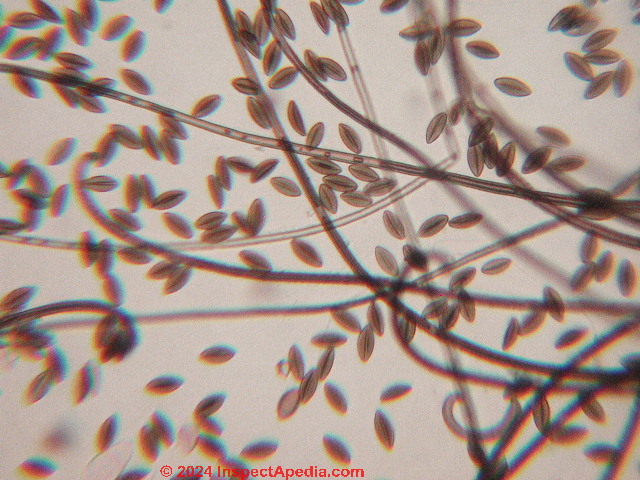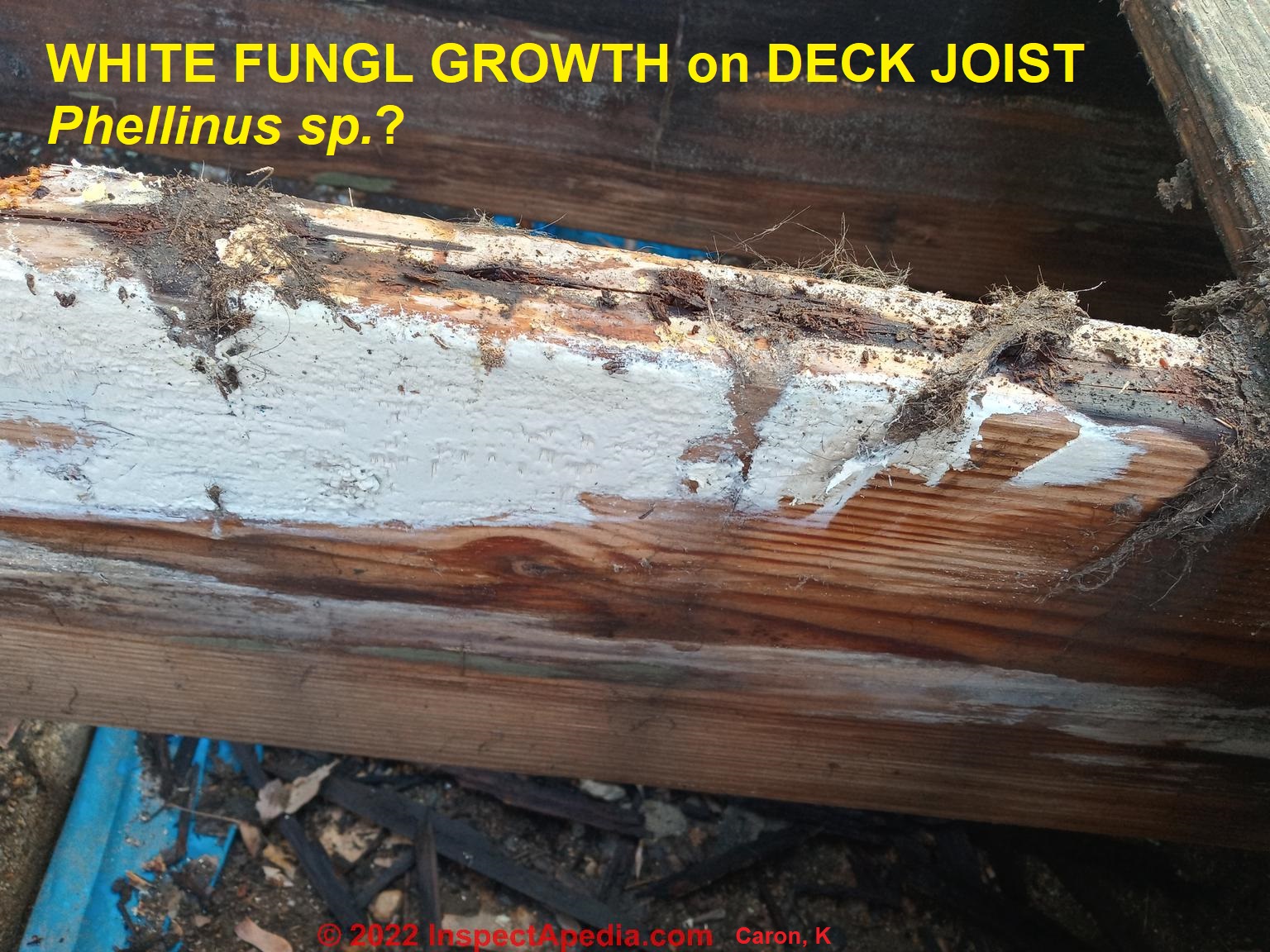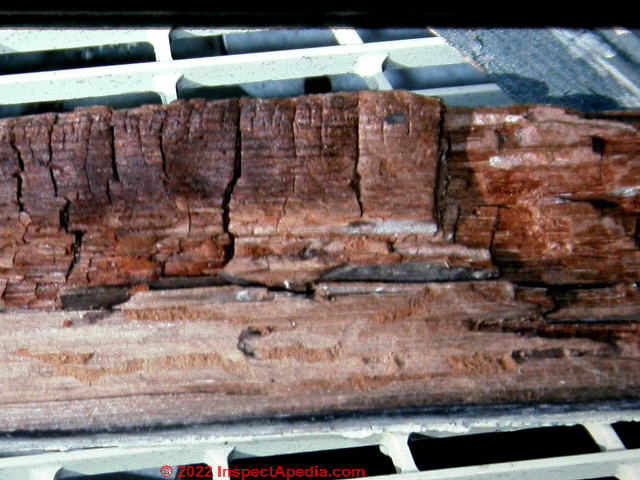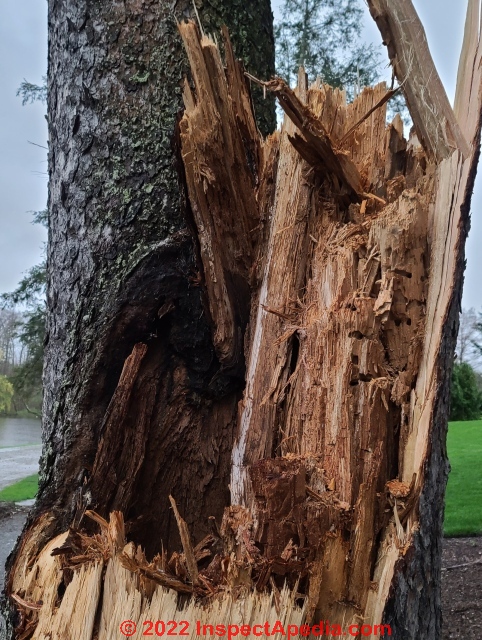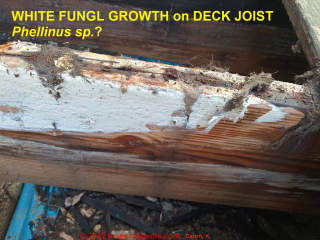 Wood Rot: Brown, White, or Soft Rot
Wood Rot: Brown, White, or Soft Rot
Appearance, cause, effect, prevention of types of wood rot
- POST a QUESTION or COMMENT about how to identify white rot, brown rot, soft rot in wood, cause, prevention, repair.
This article describes three principal types of wood rot caused by fungi (mold) or possibly a combination of fungal plus bacterial organisms.
We provide photos and descriptions of each kind of wood rot so that you can identify what's happening.
Page top photo: brown rot found in a badly-deteriorated wooden beam.
InspectAPedia tolerates no conflicts of interest. We have no relationship with advertisers, products, or services discussed at this website.
- Daniel Friedman, Publisher/Editor/Author - See WHO ARE WE?
Three Major Types of Wood Rot & Fungi (Molds)
Characteristics of Soft Rot, Brown Rot, White Rot
All wood rot is caused by wood decaying fungi, typically basidiomycetes, some assisted by certain bacteria.
Photo: from our lab analysis, Chaetomium globosum, often present in soft rot found in wood.
[Click to enlarge any image]
Soft Rot in Wood
Soft rot in wood is often by combined action of fungi and bacteria,characterized by soft, separating wood fibers.
Often the fungus present is a common species of mold: Chaetomium globosum (photo above)
See details at
- Duncan, C.G., DETERMINING RESISTANCE to SOFT-ROT FUNGI [PDF], US Forest Products Laboratory, Forest Service, USDA, Madison WI (December, 1965) FPL 48
Summary:
A laboratory procedure is outlined that incorporates techniques found to promote soft rot by several fungi. This procedure employs either an agar or a soil substrate. Also presented are the principal findings of experiments underlying the procedure.
Results of tests conducted according to the suggested procedure are illustrated. The overall decay resistance of the softwoods typically was greater than that of hardwoods. The levels of decay in softwoods, however, were substantially higher than previously obtained.
There was a tendency for decay in soil to be somewhat greater than on agar; however, a particular preference for either substrate was indicated only in a few instances.
Introduction excerpt:
Fungi Imperfecti and Ascomycetes may cause a soft-rot type of wood decay by their utilization of cellulose in the secondary walls of tracheary cells (3,7,12).2 Soft rot tends to be the dominant form of deterioration under extreme wetness or frequent dryness--conditions that retard or inhibit development of the more aggressive Basidiomycete wood-destroying fungi.
It may be desirable to know what woods or preservative treatments can be used to avoid such deterioration under these environments. - USFS, INTRODUCTION TO DECAY DISEASES OF ROOTS AND STEMS [PDF] US Forest Service, Forest Health Protection, Rocky Mountain Region (2011) retrieved 2022/04/02 original source: https://www.fs.usda.gov/Internet/FSE_DOCUMENTS/stelprdb5353717.pdf
White Rot in Wood
Above: probably white rot in a fallen tree observed in the Hudson Valley, N.Y.
White rot in wood, wood rotting fungi that produce white growths like that shown in the photo below. Also invading the wood interior. You're seeing the surface fruiting body of the fungus. Perhaps Panerochaete chrysosporium or Phellinus sp
- Croan, Suki C., PRESERVATION OF HYPHAL-FORMING BROWN- AND WHITE-ROT WOOD-INHABITING BASIDIOMYCETES [PDF] (2001) U.S. Forest Products Laboratory, IRG/WP ; 01/10397. Stockholm, Sweden : IRG Secretariat, 2001: [10] pages. Center for Forest Mycology Research, Forest Products Laboratory, U.S. Department of Agriculture, Forest Service, Madison, Wisconsin 53705–2398 Paper prepared for the 32nd Annual Meeting Nara, Japan May 20-25th, 2001
- László G Nagy, Robert Riley, Philip J Bergman3, Krisztina Krizsán, Francis M Martin, Igor V Grigoriev, Dan Cullen, David S Hibbett, GENETIC BASES OF FUNGAL WHITE ROT WOOD DECAY PREDICTED BY PHYLOGENOMIC ANALYSIS OF CORRELATED GENE-PHENOTYPE EVOLUTION [PDF] retrieved2022/04/02 original source: https://pubmed.ncbi.nlm.nih.gov/27834665/
Abstract:
Fungal decomposition of plant cell walls (PCW) is a complex process that has diverse industrial applications and huge impacts on the carbon cycle. White rot (WR) is a powerful mode of PCW decay in which lignin and carbohydrates are both degraded. Mechanistic studies of decay coupled with comparative genomic analyses have provided clues to the enzymatic components of WR systems and their evolutionary origins, but the complete suite of genes necessary for WR remains undetermined.
Here, we use phylogenomic comparative methods, which we validate through simulations, to identify shifts in gene family diversification rates that are correlated with evolution of WR, using data from 62 fungal genomes. We detected 409 gene families that appear to be evolutionarily correlated with WR. The identified gene families encode well-characterized decay enzymes, e.g., fungal class II peroxidases and cellobiohydrolases, and enzymes involved in import and detoxification pathways, as well as 73 gene families that have no functional annotation.
About 310 of the 409 identified gene families are present in the genome of the model WR fungus Phanerochaete chrysosporium and 192 of these (62%) have been shown to be upregulated under ligninolytic culture conditions, which corroborates the phylogeny-based functional inferences.
These results illuminate the complexity of WR and suggest that its evolution has involved a general elaboration o - Wilcox, Wayne W., CHANGES IN WOOD MICROSTRUCTURE THROUGH PROGRESSIVE STAGES OF DECAY [PDF] U.S. Forest Products Laboratory
Research paper FPL no. 70. Madison, WI : USDA, Forest Service, Forest Products Laboratory. 45 pages. (1968)
Description
Successive stages of decay in the sapwood of sweetgum (Liquidambar styraciflua L.), a hardwood, and of southern pine (Pinus sp.), a softwood, were observed microscopically. The white-rot fungus. Polyporus versicolor L., and the brown-rot fungus, Poria monticola Murr., were the fungi used or the observations, light microscopy, plus the techniques of polarization and ultraviolet-absorption microscopy, was used on sections 4 microns thick cut from celloidin-embedded specimens.
For both fungi, hyphae were widespread in the early stages of decay in both types of wood.
The hyphae of the white rotter were much more numerous than were those of the brown rotter. The white-rot fungus in penetrating the cell walls went through both pits and numerous bore holes: the brown-rot fungus penetrated pits almost exclusively.
Pit canals were enlarged by both fungi to the extent that they could not be distinguished from true bore holes in any but the early stages of decay.
Results indicated that the action of the cellulolytic enzymes of the white-rot fungus was restricted to the cell wall surfaces, whereas the cellulolytic enzymes of the brown-rot fungus and the lignin-destroying enzymes of the white-rot fungus were able to penetrate and act within the cell wall.
The resistance of the cell walls to brown rot was positively correlated with the lignin content. Essentially all loss in weight of wood could be accounted for by microscopically visible loss of cell wall substance.
Brown rot in wood
Above and again below our photos illustrate typical brown wood rot. Notice the characteristic rectangular "chunks" of separating wood found in brown rot.
Often both brown rot and white rot are found together in wood. In our photo above we see small areas of white rot at upper right.
Below: this large fir was blown down in a wind-storm (Vassar College Campus, 2022). Click to enlarge the image and you'll observe a combination of brown rot and insect damage, probably by carpenter ants.
Watch out: you may find wood rot and insect damage together in a structure. But they are visually distinct.
 ...
...
Brown wood rot is characterized by rather rectangular chunky segments of brown-colored rotting wood in the rot area.
- Flournoy,Douglas S.,
T. Kent Kirk,
T.L. Highley, WOOD DECAY BY BROWN-ROT FUNGI : CHANGES IN PORE STRUCTURE AND CELL WALL VOLUME [PDF] USDA, United States Department of Agriculture, Forest Service, Forest Products Laboratory*
One Gifford Pinchot Drive, Madison, WI 53705-2398, U.S.A. Agriculture, Holzforschung. Vol. 45, no. 5 (Oct. 1991): pages 383-388.
Description:
Sweetgum (Liquidambar styraciflua L.) wood blocks were decayed by Postia (= Poria) placenta in soilblock cultures. Decay was terminated at various weight losses, and the pore volumes available to four low molecular weight molecules, (water, 4 Å,; glucose, 8 Å,; maltose, 10 Å; and raffinose, 128,) and three dextrans (Mr 6,000, 38 Å; 11,200, 51 Å; nd 17,500, 61 Å) were determined by the solute exclusion technique (Stone and Scallan 1968b).
The volume in sound (undecayed) wood that was accessible to the seven probes varied from 1.0 ml g–1 for the three largest to 1.35 ml g–1 for water. Thus, the volume in sound wood attributable to lumens, pits, and other large openings was 1.0 ml g–1 and that accessible to water in the cell wall was 0.35 ml g–1.
Of this volume, 80% was inaccessible to molecules > 12 Å in diameter. As the wood was decayed, the volume of pores in the cell wall increased steadily to 0.7 ml g–1 at 35% weight loss. New cell wall volume was accessible to the four low molecular weight probes but not to molecules of Mr ³ 6,000. The increase in accessible pore volume to the four smallest probes was gradual.
Most of the new cell wall volume created by removal of components during decay was in the pore size range of 12 Å, to 38 Å. Within experimental error, no pores of > 38 Å, were observed in sound or decayed wood.
Our results are consistent with the hypothesis that the initial depolymerization of cellulose, characteristic of brown rot, is caused by a diffusible agent. The molecular diameter of the agent is apparently in the range 12 Å, to 38 Å, and it causes erosion and thus enlargement of the pores to which it has access.
Watch out: not all "brown rot" is actually wood rot. You might be looking at insect damage.
Below we show advanced power post beetle damage in a basement beam.
that we discuss in detail
at INSECT INFESTATION / DAMAGE
Also see COMPARE TERMITE DAMAGE to POWDER POST BEETLE
...
Reader Comments, Questions & Answers About The Article Above
Below you will find questions and answers previously posted on this page at its page bottom reader comment box.
Reader Q&A - also see RECOMMENDED ARTICLES & FAQs
Question: what is this white stuff on our 25-year old Wood Deck Joist? Mold?
2022/04/02 Karen Caron
After 25 years the deck made with pressure treated lumber is rotting and needs to be replaced. My husband is in the process of pulling it up. He noticed this white material on the boards under some portions of the deck.
It isn't powdery but peels off a bit like a latex or oil based paint.
I can't seem to find anything to identify it. Thoughts?
This Q&A were posted originally
at MOLD CONTAMINATION IN BUILDINGS
Moderator reply: white fungal fruiting body & sometimes white mycelia on wood
@Karen Caron,
Yep. That's a fungus or "mold" - you're seeing the fruiting body/mycelial body of a wood-rotting fungus.
Paraphrasing one of my mentors, Harriet Burge, and also my hard-to-find but favorite reference on this topic: Identification Manual for Fungi from Utility Poles in the United States, Edited by C.J.K. Wang, and R.A. Zabel. 1990. ATCC, 12301 Parklawn Drive, Rockville, Maryland 20852.
These look different when present in or on wood, but all of them damage wood, ultimately, seriously.
All three of these wood rotting fungi attack wood such as wood deck framing, causing, ultimately, structural damage that can make the structure unsafe.
Your white rot fungus might also be Phellinus sp. Phellinus sp.,is a genus of fungi in the Hymenochaetaceae famliy, of which many of its species cause white rot. In humans
As Burge describes it, "Phellinus produces flat fruiting bodies on the surface of colonized wood, and can release basidiospores into the occupied space. " (Not to panic, basidiospores are common in outdoor air).
See
- Burge, Harriet, PhD., WOOD DECAYING FUNGI TYPES, [PDF] at inspectapedia.com/mold/Wood-Decaying-Fungi-Types-Burge.pdf original source: www.scrt.org/scrt-free-reports/45-wood-decaying-fungi/file
- US FPL, GENETIC BASIS OF LIGNOCELLULOSE DEGRADATION - retrieved 2022/04/02 original source:https://www.fpl.fs.fed.us/research/highlights/highlight.php?high_id=1295
Summary:
Certain wood decay fungi have evolved the capacity to efficiently degrade all the major components of cell walls, including cellulose and the recalcitrant polymer, lignin. Collectively referred to as "white rot" fungi, these microbes play a key role in forest carbon cycles.
The unique enzymes have attracted considerable attention for their industrial potential in the bioconversion of woody biomass to useful chemicals. Nevertheless, considerable uncertainty remains regarding the identification, roles and interactions among the extracellular proteins produced by these filamentous fungi. Addressing this issue, Forest Service scientists and their collaborators compared the genomes of 62 fungi and identified 409 gene families that correlated with white rot decay.
Some of these families were previously associated with the degradation of cellulose and lignin, while others were related to detoxification and transport processes, and still others had yet unknown function. Corroborated by patterns of gene regulation, these results provide a framework for selecting more efficient enzymes of value in bioprocess development.Keep in mind that in any rotting wood structure we may also find insect damage, such as from carpenter ants or termites, and occasionally from other pests such as old house borer beetles.
25-years of life for your treated lumber deck isn't bad. You might also want to see
Watch out: when reading those tiny plastic labels stapled to your newly-purchased treated lumber or posts, be sure to distinguish between lumber treated to be rot and insect-attack resistant "above ground" (ok for deck joists) and "below grown" or "buried" ok for deck posts if their bottom ends will be placed into dirt.
In my opinion, for longest life, any new deck ought to be supported on concrete or other masonry piers supporting the deck posts so that their bottom ends are above the surface of surrounding soil.
...
Continue reading at WOOD STRUCTURE ASSESSMENT, or select a topic from the closely-related articles below, or see the complete ARTICLE INDEX.
Or see these
Recommended Articles
- BROWN MOLD PHOTOS
- FRAMING DAMAGE, INSPECTION, REPAIR - home - advice on looking for damaged, unsafe wood structure framing
- MERULIPORIA HOUSE EATING FUNGUS
- MOLD CONTAMINATION IN BUILDINGS - home
- PRESERVATIVE TREATED LUMBER
- ROT RESISTANT LUMBER
- ROT, DECK FLASHING ERRORS
- ROT, FUNGUS, TERMITES
- ROT, TIMBER FRAME
- ROT TYPES, BROWN SOFT WHITE
- SPLITS & CRACKS in STRUCTURAL WOOD BEAMS
- STRUCTURAL DAMAGE PROBING
- TERMITE IDENTIFICATION & CONTROL
- WHITE MOLD PHOTOS
- WOOD STRUCTURE ASSESSMENT
Suggested citation for this web page
ROT TYPES, BROWN SOFT WHITE at InspectApedia.com - online encyclopedia of building & environmental inspection, testing, diagnosis, repair, & problem prevention advice.
Or see this
INDEX to RELATED ARTICLES: ARTICLE INDEX to MOLD CONTAMINATION & REMEDIATION
Or use the SEARCH BOX found below to Ask a Question or Search InspectApedia
Ask a Question or Search InspectApedia
Try the search box just below, or if you prefer, post a question or comment in the Comments box below and we will respond promptly.
Search the InspectApedia website
Note: appearance of your Comment below may be delayed: if your comment contains an image, photograph, web link, or text that looks to the software as if it might be a web link, your posting will appear after it has been approved by a moderator. Apologies for the delay.
Only one image can be added per comment but you can post as many comments, and therefore images, as you like.
You will not receive a notification when a response to your question has been posted.
Please bookmark this page to make it easy for you to check back for our response.
IF above you see "Comment Form is loading comments..." then COMMENT BOX - countable.ca / bawkbox.com IS NOT WORKING.
In any case you are welcome to send an email directly to us at InspectApedia.com at editor@inspectApedia.com
We'll reply to you directly. Please help us help you by noting, in your email, the URL of the InspectApedia page where you wanted to comment.
Citations & References
In addition to any citations in the article above, a full list is available on request.
- In addition to citations & references found in this article, see the research citations given at the end of the related articles found at our suggested
CONTINUE READING or RECOMMENDED ARTICLES.
- Carson, Dunlop & Associates Ltd., 120 Carlton Street Suite 407, Toronto ON M5A 4K2. Tel: (416) 964-9415 1-800-268-7070 Email: info@carsondunlop.com. Alan Carson is a past president of ASHI, the American Society of Home Inspectors.
Thanks to Alan Carson and Bob Dunlop, for permission for InspectAPedia to use text excerpts from The HOME REFERENCE BOOK - the Encyclopedia of Homes and to use illustrations from The ILLUSTRATED HOME .
Carson Dunlop Associates provides extensive home inspection education and report writing material. In gratitude we provide links to tsome Carson Dunlop Associates products and services.


